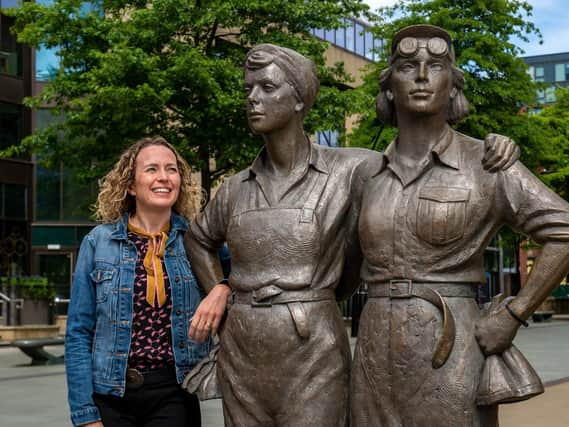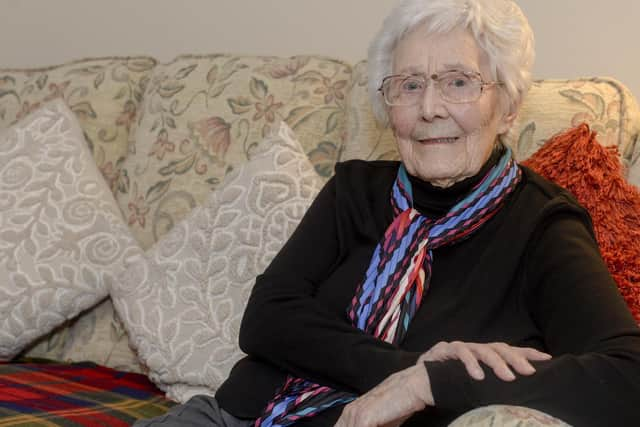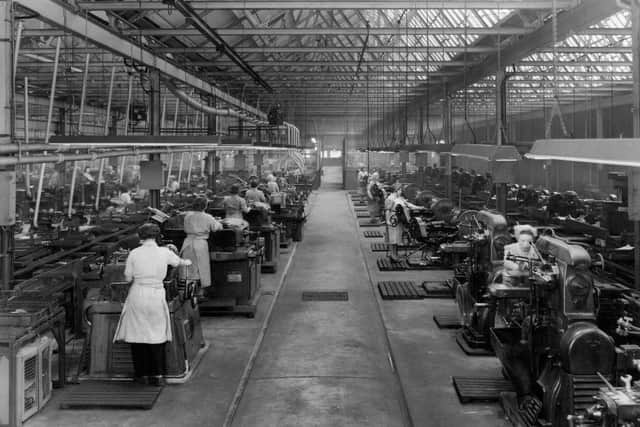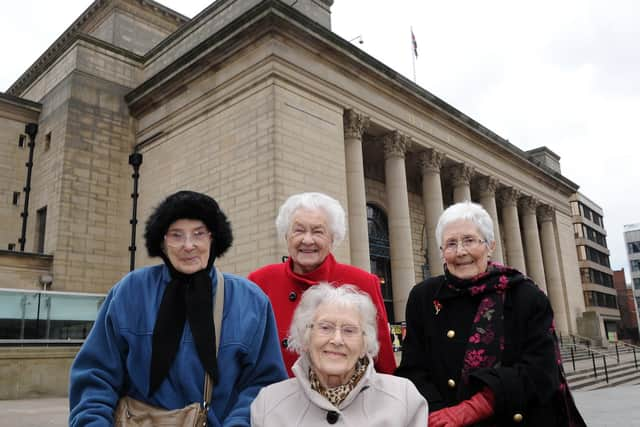The moving story of Sheffield's remarkable Women of Steel


They came to be known locally as the Sheffield Blitz and Kathleen Roberts, who was 18 at the time, remembers them well.
“My dad had just gone to work because he was on nights, and my mother and I and my two sisters spent the night under the stairs. Across the road there was a pub called The Pheasant and a land [parachute] mine dropped nearby and I remember every door in our house was blown wide open and we all ended up in a pile in the hallway. The next thing we knew a fire warden was standing there saying ‘is everybody all right?’”
Advertisement
Hide AdAdvertisement
Hide AdThankfully they were. But not everyone was so fortunate. The attacks killed 668 civilians and 25 servicemen, injured more than 1,500 others and left a tenth of the city’s population homeless.


The morning after the attacks, Kathleen was back at Metro-Vickers where she worked. “I had to be there for six in the morning. The trams weren’t working so I had to walk the five miles to work.”
Kathleen is one of the last surviving Sheffield steelworkers from the war and is among those that journalist Michelle Rawlins spoke to for her excellent new book, Women of Steel.
When war broke out, the lives of the young women of Sheffield were turned upside down. With the men sent away to fight they had no choice but to step into their shoes and became the backbone of the city’s steel industry. Through hard graft and companionship in the gruelling, and often dangerous world of factory work, they vowed to keep the foundry fires burning.


Advertisement
Hide AdAdvertisement
Hide Ad“Lots of the men who still worked in the factories resented them being there to begin with, but as time went on and the number of men working there dropped they relied on the women who came in.”
It isn’t known exactly how many women worked in the city’s steelworks during the war but they number in the hundreds, possibly thousands. And they came from all manner of backgrounds, working as everything from heavy machine operators to crane drivers.
“There was a real mix, there were the old buffer girls who’d been in the steel polishing industry, but you also had women who worked as nannies or in sweet shops. They all felt compelled to come and do their bit,” says Rawlins.
Sheffield’s steelworks were a vital cog in the nation’s war effort, producing everything from crankshafts for Spitfires and Hurricanes, to artillery shells, camouflage nets and tank treads.


Advertisement
Hide AdAdvertisement
Hide AdThe women often worked with molten steel where one mistake could leave you maimed or dead. The hours were long and burns injuries, in particular, weren’t uncommon. “There were a lot of awful injuries in the factories but these women kept on working because they knew how important it was. They did eight to 12 hour shifts and worked six days a week, and that was their life for six years.”
Kathleen Roberts spent most of the war working at Brown Bayleys steelworks. “I worked in a rolling mill. I worked with a man called Joe because you always had to work with a ‘mate’. You couldn’t just do it on your own and I was with him for three or four years,” she says.
“We’d replaced the men who’d gone into the Forces and we were doing all manner of things that you wouldn’t think a woman could do. Some of the women worked on huge paring machines which had massive blades. I saw many a finger chopped off…”
Her own job on the strip rolling machine could be hazardous. “The steel was on a drum and sent through these rollers, they were seven inches wide and there were seven coils all joined together. It was quite dangerous because where they’d been joined together they could have snapped when they were going through the rollers, and if you were in its path you’d get your head chopped off, so you had to be very careful.”
Advertisement
Hide AdAdvertisement
Hide AdThe women proved to be the equals of their male counterparts. “My foreman said to me one day ‘you ladies are better at some of these jobs than the men are, because your fingers are more nimble.’ And I thought that was praise indeed.”
They might have earned praise but they only got paid a fraction of what the men did, something they only discovered after the war was over. “I used to work 72 hours a week. It was nights one week and days the next, and on a week of nights that would be my best week because I’d get just over £5 in my wage packet.”
Despite being paid a pittance and the gruelling nature of the work, there was a real camaraderie between the women. “I worked with some wonderful girls,” says Kathleen.
“A lot of us had husbands in the Forces and we would take care of each other when we got telegrams to say they had been injured or killed in action. But nobody ever took a day off even if they did get a telegram like that. I had three telegrams on different occasions during the war which my dad brought to the works, informing me that my husband, who was in the 8th Army, had been injured.”
Advertisement
Hide AdAdvertisement
Hide AdHowever, when the men came back in 1945 and returned to their old jobs, many of the women were simply pushed aside. “We got a note in our pay packet saying we were no longer required. We were all very annoyed and hurt by that.”
They were, as Rawlins puts it, discarded ‘‘like yesterday’s fish and chip wrappers’’. However, there was little the women could do. “Nobody knew what we women were doing because we were told when we got the job that we mustn’t speak about it to anyone, because we were told ‘the walls have ears’,” adds Kathleen.
Not only did most of the women lose their jobs, many also had to nurse their returning husbands who had often either been injured or left psychologically scarred by the war.
“It was almost like it didn’t happen,” Rawlins says of the role of female steelworkers. “There was no mention of it in the history books and no official thanks, and so most people didn’t know what these women had been through.”
Advertisement
Hide AdAdvertisement
Hide AdTheir story was at risk of slipping from memory until decades later a grassroots campaign spearheaded by four of the elderly women of
steel – Dorothy Slingsby, Ruby Gascoigne, Kit Sollitt and Kathleen – brought it to light and they finally received the thanks they deserved.
“We felt it was important that the women of Sheffield were recognised for what they did, and we thought it would be wonderful if we could get a statue made,” says Kathleen.
So they set about trying to drum up support. “We went to all the steelworks, we did as many talks as we could and we enjoyed every minute of it.”
Advertisement
Hide AdAdvertisement
Hide AdA campaign by Sheffield’s newspaper The Star helped raise money for a Women of Steel statue which was finally unveiled in the city centre in 2016. It not only commemorates the women who worked in Sheffield during the Second World War, but also those who took on many roles during the First World War. “I’m the last one of those women of steel, the other three have sadly passed away and I do miss them,” says Kathleen, now 98. “But we were all proud of what we did.”
As we are of them. For Kathleen and all the remarkable women who gave so much to keep the country going during its darkest days were as brave as the soldiers who set foot on the battlefield, and their stoicism and sacrifice is an example to us all.
Women of Steel, published by Headline, is out now priced £16.99.
Editor’s note: first and foremost - and rarely have I written down these words with more sincerity - I hope this finds you well.
Advertisement
Hide AdAdvertisement
Hide AdAlmost certainly you are here because you value the quality and the integrity of the journalism produced by The Yorkshire Post’s journalists - almost all of which live alongside you in Yorkshire, spending the wages they earn with Yorkshire businesses - who last year took this title to the industry watchdog’s Most Trusted Newspaper in Britain accolade.
And that is why I must make an urgent request of you: as advertising revenue declines, your support becomes evermore crucial to the maintenance of the journalistic standards expected of The Yorkshire Post. If you can, safely, please buy a paper or take up a subscription. We want to continue to make you proud of Yorkshire’s National Newspaper but we are going to need your help.
Postal subscription copies can be ordered by calling 0330 4030066 or by emailing [email protected]. Vouchers, to be exchanged at retail sales outlets - our newsagents need you, too - can be subscribed to by contacting subscriptions on 0330 1235950 or by visiting www.localsubsplus.co.uk where you should select The Yorkshire Post from the list of titles available.
If you want to help right now, download our tablet app from the App / Play Stores. Every contribution you make helps to provide this county with the best regional journalism in the country.
Sincerely. Thank you.
James Mitchinson
Editor
Thanks